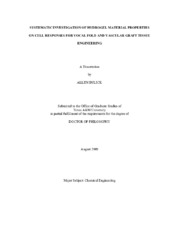| dc.description.abstract | The research presented here deals with synthetic materials for application in
tissue engineering, primarily poly(ethylene glycol) (PEG) and poly(dimethyl siloxane)star
(PDMS)star. Tissue engineering seeks to repair or replace damaged tissue through
implantation of cell encapsulated in an artificial scaffold. Cell differentiation and
extracellular matrix (ECM) deposition can be influenced through a wide variety of in
vitro culture techniques including biochemical stimuli, cell-cell interactions, mechanical
conditioning and scaffold physical properties. In order to systematically optimize in
vitro conditions for tissue engineering experiments, the individual effects of these
different components must be studied. PEG hydrogels are a suitable scaffold for this
because of their biocompatibility and biological "blank slate" nature.
This dissertation presents data investigating: the effects of glycosaminoglycans
(GAGs) as biochemical stimuli on pig vocal fold fibroblasts (PVFfs); the effects of
mechanical conditioning and cell-cell interactions on smooth muscle cells (SMCs); and
the effects of scaffold physical properties on SMCs. Results show that GAGs influence PVFf behavior and are an important component in scaffold design. Hyaluronic acid (HA) formulations showed similar production in collagen I and III as well as reduced
levels of smooth muscle a-actin (SMa-actin), while chondroitin sulfate (CSC) and
heparin sulfate showed enriched collagen III environments with enhanced expression of
SMa-actin.
A physiological flow system was developed to give comprehensive control over
in vitro mechanical conditioning on TEVGs. Experiments performed on SMCs involved
creating multi-layered TEVGs to mimic natural vascular tissue. Constructs subjected to
mechanical conditioning with an endothelial cell (EC) layer showed enhanced
expression of SMC differentiation markers calponin h1 and myocardin and enhanced
deposition of elastin. Consistent with other studies, EC presence diminished overall
collagen production and collagen I, specifically.
Novel PDMSstar-PEG hydrogels were studied to investigate the effects of
inorganic content on mesenchymal stem cell differentiation for use in TEVGs. Results
agree with previous observations showing that a ratio of 5:95 PDMSstar: PEG by weight
enhances SMC differentiation markers; however, statistically significant conclusions
could not be made. By studying and optimizing in vitro culture conditions including
scaffold properties, mechanical conditioning and multi-layered cell-cell interactions,
TEVGs can be designed to maximize SMC differentiation and ECM production. | en |


